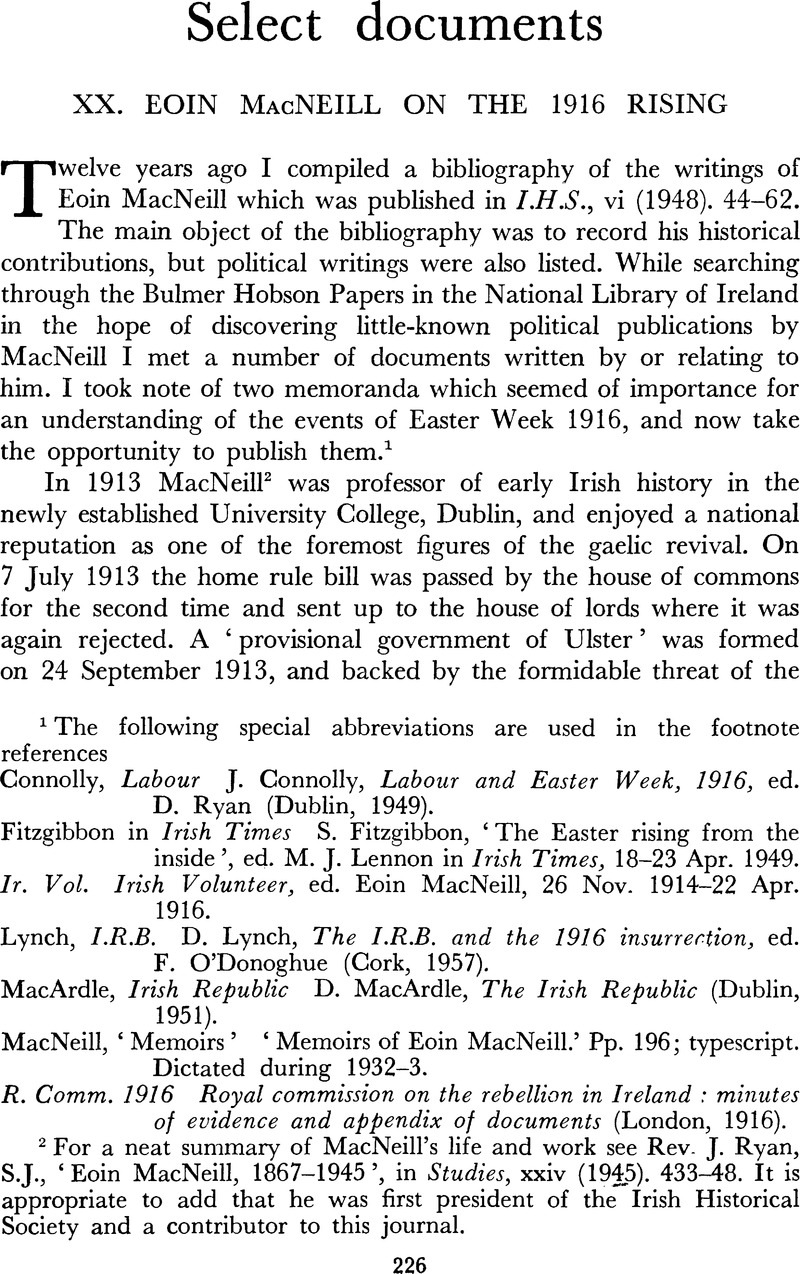Published online by Cambridge University Press: 28 July 2016

1 The following special abbreviations are used in the footnote references
Connolly, , Labour Connolly, J., Labour and Easter Week, 1916, ed. Ryan, D. (Dublin, 1949)Google Scholar.
Fitzgibbon, in Irish Times Fitzgibbon, S., ‘The Easter rising from the inside’, ed. Lennon, M. J. in Irish Times, 18–23 Apr. 1949.Google Scholar
Ir. Vol Irish Volunteer, ed. MacNeill, Eoin, 26 Nov. 1914–22 Apr. 1916.Google Scholar
Lynch, , I.R.B. Lynch, D., The LR.B. and the 1916 insurrection, ed. O’Donoghue, F. (Cork, 1957)Google Scholar.
MacArdle, , Irish Republic MacArdle, D., The Irish Republic (Dublin, 1951).Google Scholar
MacNeill, , ‘Memoirs’ ‘Memoirs of Eoin MacNeill.’ Pp. 196 Google Scholar; typescript. Dictated during 1932–3.
R. Comm. 1916 Royal commission on the rebellion in Ireland : minutes of evidence and appendix of documents (London, 1916).
2 For a neat summary of MacNeill’s life and work see Rev. Ryan, J., S.J., ‘Eoin MacNeill, 1867–1945’, in Studies, 24 (1945). 433–48Google Scholar. It is appropriate to add that he was first president of the Irish Historical Society and a contributor to this journal.
3 MacNeill’s wish that the new armed body should not be formed in a spirit of hostility to the Ulster Volunteer Force was embodied in the Irish Volunteer declaration of 25 November that their object was ‘to ensure and maintain the rights and liberties common to all the people of Ireland without distinction of creed, class or politics’, Hobson, B., A short history of the Irish Volunteers (Dublin, 1918), p. 28.Google Scholar
4 Hobson, B., ‘The origin of Ógláigh na hÉireann’, in An t-Óglách, Mar. 1931, pp. 1–4 Google Scholar; Lynch, , I.R.B., pp. 23–4.Google Scholar
5 Seán O’Kelly, T. in An Phoblacht, 30 Apr. 1926, p. 5 Google Scholar. For the names of the members of the governing committee of the Irish Volunteers from Nov. 1913 to Oct. 1914 (exclusive of Redmond’s nominees who functioned from mid-June to mid-Sept. 1914), with a list of those who were members of the I.R.B., see Lynch, , I.R.B., p. 96.Google Scholar
6 For the military council see ibid., pp. 25, 47–8, 102, 112, 130–2.
7 See below, Memorandum II, n. 5.
8 Ibid., n. 12, 13.
9 Written statement of Bulmer Hobson to Rev. Martin, F. X., O.S.A., 17 Mar. 1960.Google Scholar
10 Le Roux, L. N., Patrick H. Pearse, trans. Ryan, D. (Dublin, 1932), p. 360.Google Scholar
11 Statement of Hobson, B. to Rev Martin, F. X., O.S.A., 17 Mar. 1960.Google Scholar
12 See below, Memorandum II, n. 59, 60.
13 Ibid., n. 42.
14 Ibid., n. 4.
15 Cf. Roux, Le, Pearse, pp. 326–66Google Scholar, and Tom Clarke and the Irish freedom movement (Dublin, 1936), pp. 125–212.
16 Sentence of penal servitude for life was passed on MacNeill on 24 May 1916 at Richmond Barracks. In June his solicitor, Edward Byrne, obtained an official copy of the court martial proceedings from the Judge Advocate General’s Office, London. This explains how a full typescript copy of the proceedings, running to 118 folio pages, came into the possession of the MacNeill family. It is entitled ‘Proceedings of a general court martial held at Dublin on the 22nd day of May 1916 by order of General Sir J. G. Maxwell...... commanding in chief the forces in Ireland, dated the 18th of May 1916’, and is hereafter cited as ‘MacNeill court martial proc.’.
17 Roux, Le, Pearse, p. 360.Google Scholar
18 Ryan, D., The rising (Dublin, 1957), p. 145.Google Scholar
19 See below, Memorandum II, n. 57.